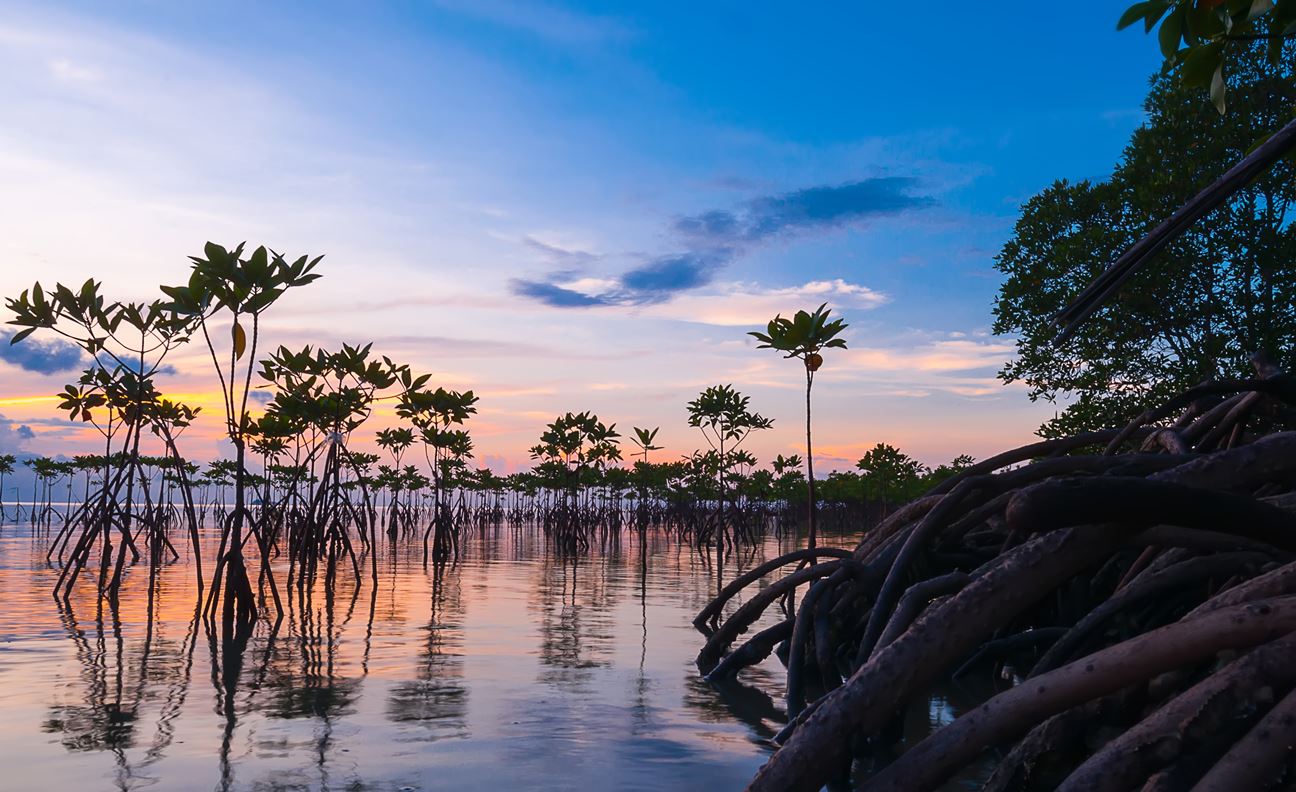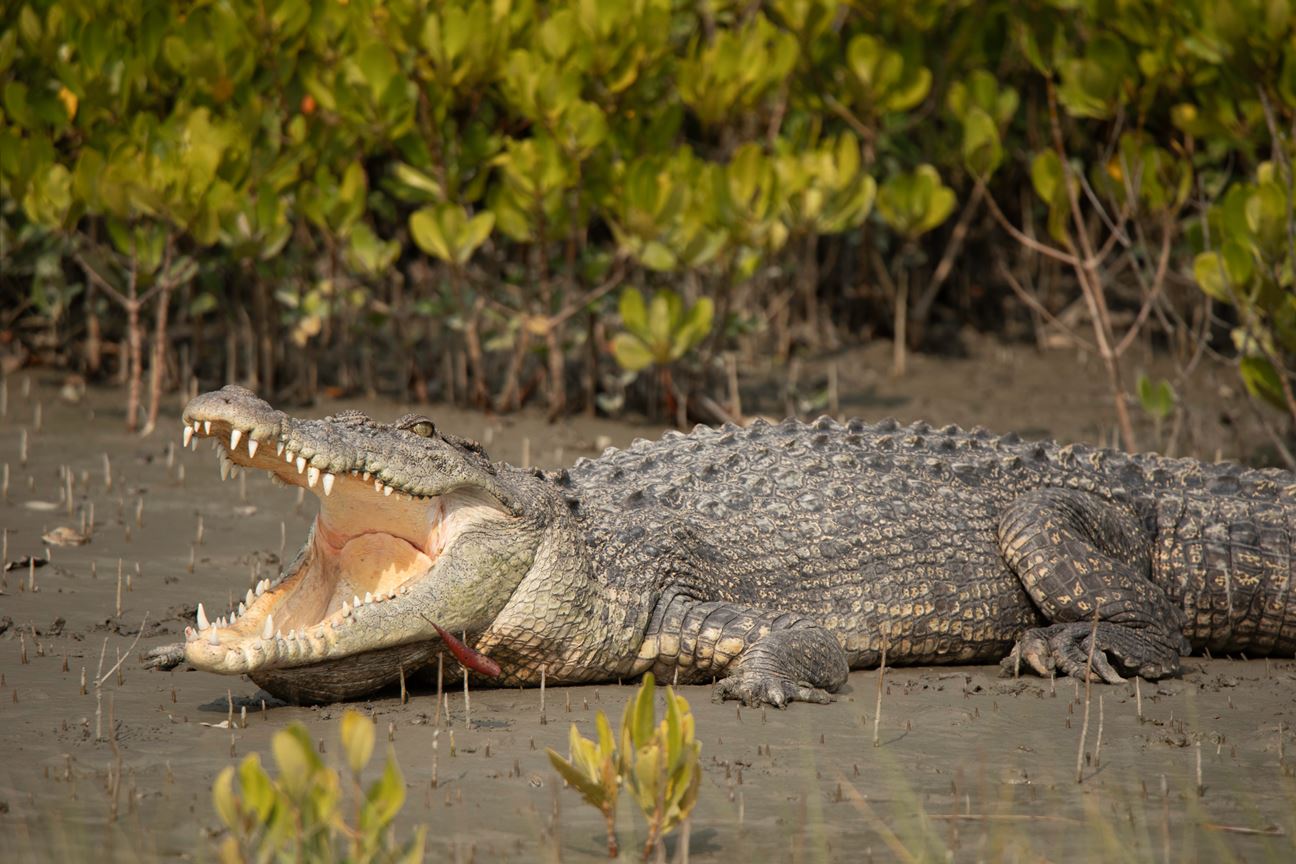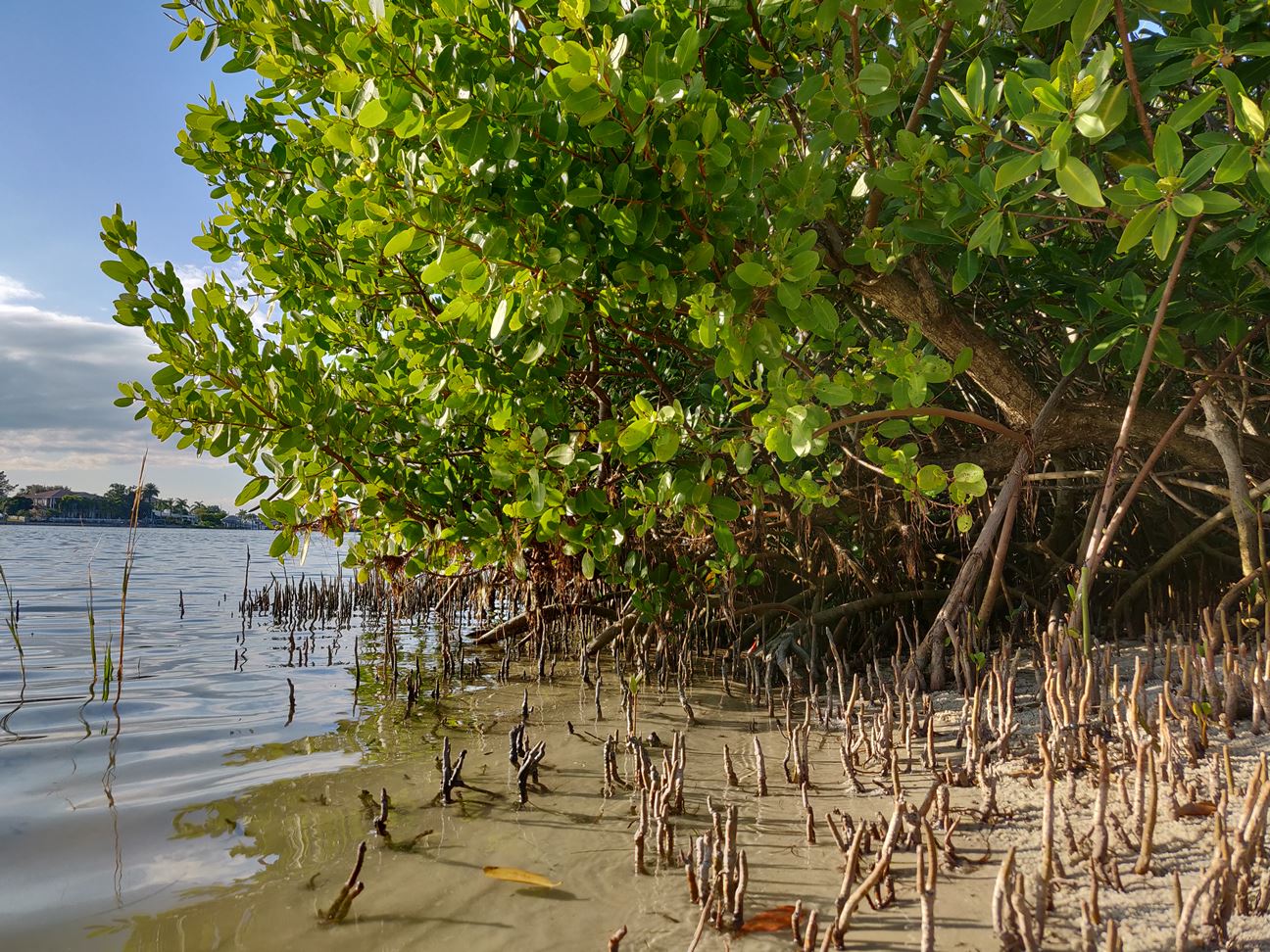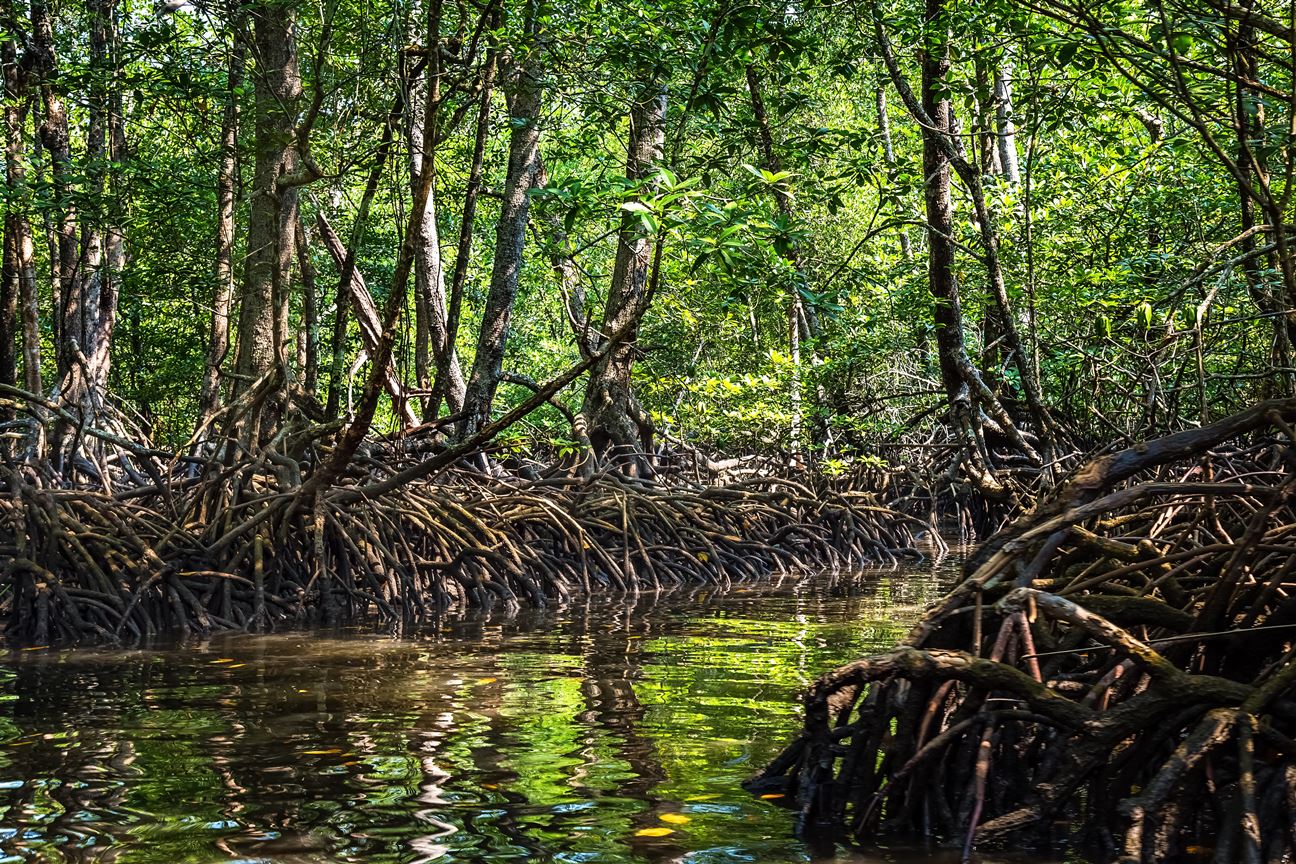Mangroves are highly dynamic ecosystems. The jumbled network in India is known to support some of the most amazing wildlife. Let's find out!
Mangrove forests thrive in one of the most contrasting environments on earth—where land meets the sea. Interestingly, these intertidal zones come with their own set of ever-changing physical and chemical conditions: powerful and transitional tides, high salinity, waterlogged soils, high rainfall, at times extreme drought even, and lack of freshwater supply. This relatively small space between land and sea faces exceptional challenges within short periods of time, thus making it imperative that mangrove species showcase complex adaptation and survival skills.

Young sprouts in mangrove forest
Salt-tolerant plant species that support a variety of wildlife characterise mangrove forests. These trees and shrubs live alongside each other while creating their own niche - depending on diverse gradients including salinity, among others. Mangrove forests are marginal ecosystems, with one or, more rarely, few species of plants that make for dominant species. They are uniquely vulnerable and fragile and can tolerate extreme environmental conditions, which make them competitive. Most commonly and exclusively found plant species include woody halophytes.
The impressively tall and evergreen mangrove forests are home to some remarkably diverse faunal species that uniquely combine both terrestrial and marine animal species in a single ecosystem. While there are very few animal species that are exclusive to mangroves, the residents and occasional visitors include many orders of vertebrates like mammals, migratory birds, and reptiles and amphibians. Invertebrates, on the other hand, are abundantly found and include molluscs and a variety of insects.
Let us look at some mangrove forests in India that provide essential habitat for many amazing animal and bird species. And later, understand why mangroves matter.
Mangrove Forests In India And The Animal Life They Support
 A saltwater crocodile seen in the sundarban mangroves
A saltwater crocodile seen in the sundarban mangroves
India and Bangladesh share the Sundarban forest, the largest estuarine mangrove in the world. The forest is spread over 200 islands on the Ganga - Brahmaputra delta. These islands are connected by 400 interconnected tidal creeks and canals and are surrounded by saline mudflats and huge mangrove forests. Towards the end of the 19th century, this forest was home to many wild animals including Bengal tigers, leopards, Indian rhinoceros, wild buffaloes, wild hogs, wild cats, swamp deer or the barasingha, spotted deer, hog deer, barking deer, and a variety of monkeys. Over the next 100 years, unfortunately, habitat degradation took its toll. But Sundarban is the only mangrove forest in the world that is home to an indigenous tiger population and remains the largest home of the Royal Bengal Tiger. As of 2020, close to 100 tigers live here.
Besides the Bengal Tigers, this forest has an array of rare wildlife species, like the Indian Python, Estuarine Crocodile and Irrawaddy Dolphins. A few other rare and globally threatened animals include water monitor lizard, Gangetic dolphin, Siberian ducks, northern river terrapin, green sea turtle, and olive ridley turtles. Sundarbans are also home to 248 species of beautiful birds! Herons, Large and Small Spoonbills, Egrets, Cormorants, and Storks can be found in plenty here. Besides this, there are over 65 varieties of mangrove trees here.
Sundarbans offer fantastic experiences to its visitors. One can take a morning boat ride through its narrow creeks and canals, or walk inside the largest mangrove forest of earth. Marichjhanpi, Ghoramara Island, and New Moore Island are some places not to miss.
- Godavari – Krishna Mangroves
The many estuaries of the Godavari and Krishna rivers form the second-largest mangroves in India and run as a narrow band along the earthen coast of India - from Odisha right down to Tamil Nadu! Interestingly, Godavari – Krishna Mangroves form the first line of defence against the frequent cyclonic tidal surges on India's east coast. This ecoregion comprises 35 mangrove species, of which 16 species require both freshwater and saltwater to survive.
These structurally complex forests are habitats for many vertebrates and invertebrates. Larger predators like the saltwater crocodile and water monitor lizard from the flagship species of the Godavari-Krishna Mangroves, while mammalian predators like the fishing cat, golden jackal, and smooth-coated otter are also seen spotted here. The now threatened, lesser florican bird species along with over 140 species of bird fauna also live in the dense canopy of these forests. One can also chance upon spotting aquatic birds such as flamingoes, spot-billed pelicans, and painted storks with their striking white, pink, and black plumage. What’s even more interesting is the aquatic fauna. These mangrove forests are a storehouse of underwater life that displays fascinating ecological adaptations. Occupiers include air-breathing territorial mudskipper fish, hermit crabs with their hook-shaped tails, and fiddler crabs who help in the iron reduction and nitrification of the mudflats.
Unfortunately, most parts of these forests are not protected. But one can visit the mangrove communities at Pulicat Lake, Chilika Lake, and Point Calimere.
- Pichavaram Mangroves, Tamil Nadu
The incredibly beautiful Pichavaram Mangroves located in the Cuddalore district of Tamil Nadu are interconnected by over 4,000 big and small intrinsically connected canals and some 50 islands of various sizes! The mangrove is rooted in the complex Vellar-Coleroon delta along the eastern coast of the state, where long sandy banks separate the forest from the Bay of Bengal.

A mix of red mangroves (Rhizophora mangle) and black mangroves (Avicennia germinans) growing along the water's edge
Some 20 varieties of mangroves grow along the sheltered, muddy shores in water that is between 3 and 10 feet deep. This rich ecosystem is an important breeding and nesting ground for birds, mammals, fish, crustaceans, shellfish, and reptiles! As one of the healthiest mangroves in the world, some 177 species of birds live here. Rare species of Avicennia and Rhizophora support many underwater life forms like shellfishes, seaweed, fish, prawns, crabs, and oysters, who rely on these forests as a nursery. Owing to its incredible biodiversity, Pichavaram Mangroves are visited by many nature enthusiasts. If you plan to visit, you can explore the forest by boat.
- Bhitarkanika Mangroves, Odisha
The Bhitarkanika Mangroves (which means "exceptionally beautiful interiors" in Oriya) is situated in the northeastern part of Odisha. This mangrove forest is along the estuarine confluence of three rivers - Brahmani, Patasala, and Baitarani and is the world's largest breeding and nesting ground for the Olive Ridley Turtles. At the Gahirmatha Beach here, millions of these turtles lay eggs every year between the months of January and May.
The Bhitarkanika mangrove ecosystem is very complex and dynamic. A regular tidal inflow from the sea and an influx of freshwater from adjoining rivers ensure that all life forms here are well taken care of. These forests, with over 60 mangrove species, form a variety of habitats and microhabitats. One can spot some amazing wildlife here. Bhitarkanika Mangroves harbour the largest population of estuarine crocodiles. Reptilian fauna, like Bibron's soft-shelled turtle, hawksbill and leatherback turtles, the rare White Crocodile (Sankhua), king cobra, Indian rock python, and water monitor are also found in abundance here. In addition, terrestrial animals like fishing cats, leopards, jackals, hyenas, porcupines, and otters, and over 250 bird species together, form many interconnected food webs, thus helping maintain the balance of nature.
- Baratang Island Mangroves, Andamans

Mangrove swamp with dense foliage at Baratang island Andaman
Baratang Island is one of the many islands of Andaman and is best known for its prehistoric limestone caves. Tourists flock to see the caves, but what’s even more interesting is the journey to these caves. As the boat passes through a dense mangrove forest, you may find yourself often ducking under the looming trees. This rich canopy of mangroves, of which over 65% is very dense mangroves, is home to some amazing wildlife. Be watchful as you ride through this forest, for you can often spot saltwater crocodiles!
Why Mangroves Matter
As seen, mangroves are much more than just swampy wastelands. They not only keep our coastal zones healthy, but the underwater roots provide ideal breeding grounds for many fish, shrimp, crabs species. Mangrove forests also act as a very productive food web. The leaves that fall off the trees and into the water decay, thus acting as food for the invertebrates and algae. These, in turn, feed other smaller organisms like worms, fish, and even birds. The ever-circling tides make sure that the nutrients are circulated well among the mudflats.
Mangroves are beneficial for both saltwater and freshwater ecosystems. While their complex roots filter out the nitrates and phosphates from the rivers and streams before it reaches the sea, it is the same roots that stop the seawater from entering the inland freshwater waterways. This helps keep the coastline clean. The roots also act as a buffer zone that protects the shorelines against erosion.
As for humans, mangroves provide many resources such as food, fuel, medicines, and wood, thus helping the survival and livelihood of those living near the coasts.
While these ecosystems are relatively small, they are remarkably evolved. The mangrove forests of India are highly productive and intensely interact with other ecosystems. What makes them so unique is that this exchange is not just limited to the neighbouring ecosystems. In fact, the tidal and coastal currents carry the organic matter to vast distances. If you have not yet seen a mangrove, these fascinating forests are definitely worth your visit.